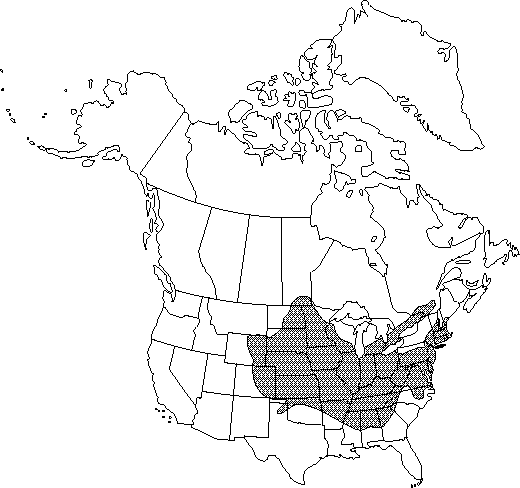Celtis occidentalis
Sp. Pl. 2: 1044. 1753.
Trees or shrubs, size varying greatly in response to habitat; crowns rounded. Bark gray, deeply furrowed, warty with age. Wood light yellow, weak. Branches without thorns, spreading, young branches mostly pubescent. Leaves: petiole 0.5-1.2 mm. Leaf-blade lanceovate to broadly ovate or deltate, 5-12 × 3-6 (-9) cm (on fertile branches), leathery, base oblique or obliquely somewhat acuminate, margins conspicuously serrate to well below middle, teeth 10-40, apex acuminate; surfaces scabrous. Inflorescences dense pendulous clusters. Drupes dark orange to purple or blue-black when ripe, orbicular, to 7-11 (-20) mm diam., commonly with thick beak; pedicel to 15 mm. Stones cream colored, 7-9 × 5-8 mm, reticulate. 2n = 20, 30, and 40.
Phenology: Flowering late winter–spring (Mar–May).
Habitat: In rich moist soil along streams, on flood plains, on rock, on wooded hillsides, and in woodlands
Elevation: 0-1800 m
Distribution

Man., Ont., Que., Ala., Ark., Colo., Conn., Del., D.C., Ga., Ill., Ind., Iowa, Kans., Ky., Maine, Md., Mass., Mich., Minn., Miss., Mo., Nebr., N.H., N.J., N.Y., N.C., N.Dak., Ohio, Okla., Pa., R.I., S.C., S.Dak., Tenn., Tex., Vt., Va., W.Va., Wis., Wyo.
Discussion
Celtis occidentalis is valued as an ornamental street tree because of its tolerance to drought.
Native Americans used decoctions prepared from the bark of Celtis occidentalis medicinally as an aid in menses and to treat sore throat (D. E. Moerman 1986).
This is a highly variable species. Segregates named as varieties follow an east-west geographic gradient and are based primarily on leaf size, shape, and pubescence.
Selected References
None.